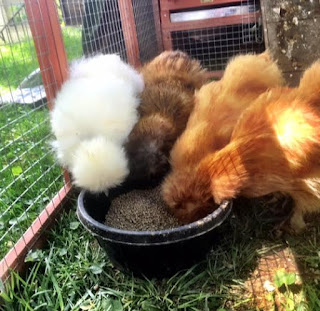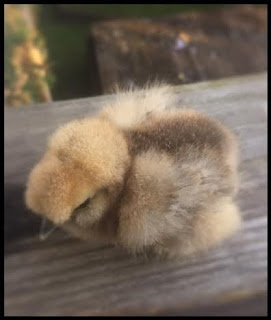Here are my girls gobbling up their late lunch meal today; crumbles.
Silkie Chickens Online
Friday, May 6, 2016
Layer Crumbles: It's What's For Dinner
My previous flock of chickens would go hungry rather than eat layer pellets. They only wanted the crumbled feed, thankyouverymuch. I found this rather frustrating because, as this chicken blogger notes, there are multiple advantages to the pellets over the much messier crumbled feed. But if the birds won't eat it, there's no advantage to be had. And so I continue to buy layer crumbles for my newer flock of silkies, even as I eyeball the bags of pellets every time I worship at the High Altar of Tractor Supply.
Here are my girls gobbling up their late lunch meal today; crumbles.
Here are my girls gobbling up their late lunch meal today; crumbles.
What Color Is My Silkie?
So here's Tubby the Silkie chick at around one week old. And the question of the day is what color she's going to be when she loses her baby down and grows actual feathers.
I am guessing that she will be some variation of partridge color when she matures, but I'd love some input from some of you who are more experienced with raising Silkie chicks. So what color do you think she will be?
I am guessing that she will be some variation of partridge color when she matures, but I'd love some input from some of you who are more experienced with raising Silkie chicks. So what color do you think she will be?
Thursday, May 5, 2016
Feather Sexing and Silkies
Leaving aside the fact that "feather sexing" sounds rather naughty, I find the idea that it may be possible to determine a very young chick's gender from the way his/her wing feathers come in to be intriguing. If you Google the term "feather sexing," you'll find lots of contradictory info online about whether feather sexing is even possible and how to do it. There's a great deal of skepticism that it's possible at all.
However, I've found one apparently authoritative source on the topic which claims that it's quite possible to determine baby chicks'gender simply by taking a very close look at their wing feathers during the first week after they hatch. Specifically, this source says that chicks that show faster feathering with longer feathers during the first week of life will be pullets. I really hope that this is the case because our 4-8 day old chick Tubby's wing feathers are growing faster & longer than any chick I've ever seen. Check it out.
What's your opinion of feather sexing baby chicks? Do you think it's a reliable indicator of gender or just an old wives' tale? Have you had any luck using this method with your own chickens (and were the chickens a particular breed?)
What's your opinion of feather sexing baby chicks? Do you think it's a reliable indicator of gender or just an old wives' tale? Have you had any luck using this method with your own chickens (and were the chickens a particular breed?)
From Big to Bantam
At our old house we had a a huge chicken house and six very large hens. As moving day grew closer, it became clear that there was no way to move the chicken house, plus C and G were not enjoying the hens that much because the chickens were so huge. The girls were too little to be able to pick them up, and when they did, they often got scratches,
I'd been thinking for a while to go to an all-bantam flock that the kids could enjoy and maybe do 4-H when C hits fourth grade in the fall., I was active in 4-H all the way through elementary, middle and high school and had a blast. I was even the Tennessee state horse judging champion. Woohoo!
But I digress.... I decided that our move to a new, much smaller house would make for the right time to acquire more kid-sized chickens - bantams. As for the large-breed hens we already had, my friend Glenn, who has a farm was more than happy to add six laying hens to his large breed block. So that worked out well.
After we had been in the our new house for about a month, we picked out a new chicken coop. My dream coop (SOMEDAY!) is the Omlet Eglu with the walk in run. Unfortunately, I do not have 2k to drop on a new chicken coop, so we went with this one.
I'd been thinking for a while to go to an all-bantam flock that the kids could enjoy and maybe do 4-H when C hits fourth grade in the fall., I was active in 4-H all the way through elementary, middle and high school and had a blast. I was even the Tennessee state horse judging champion. Woohoo!
But I digress.... I decided that our move to a new, much smaller house would make for the right time to acquire more kid-sized chickens - bantams. As for the large-breed hens we already had, my friend Glenn, who has a farm was more than happy to add six laying hens to his large breed block. So that worked out well.
After we had been in the our new house for about a month, we picked out a new chicken coop. My dream coop (SOMEDAY!) is the Omlet Eglu with the walk in run. Unfortunately, I do not have 2k to drop on a new chicken coop, so we went with this one.
It's a very handy coop because we can move it to different patches of grass tp keep thinjs clean, plus the chickens can scratch and peck at fresh grass and worms each time we move it to a new spot in the yard.. My very large coop at the old house had an actual floor on it which was a MONSTER to keep clean. I don't think I'll ever have a floored coop again (unless it's the Eglu, which can be totally hosed down). The other good thing about this new coop is that you can easily expand the pen to make it bigger, which we plan to do. We also allow our hens to free range in our fully fenced yard when I am able to watch them. The coop element of my new coop-and-pen set up may look small but it offers plenty of room for my small flock of Silkies to roost and lay eggs (which none of them have done yet).
Now it was time for us to start our new, all-bantam flock for our new, bantam-sized house, coop and yard. There was really little question in my mind that I wanted us to have Silkies. In my opinion, there's no better breed of chicken for children because Silkies are so calm and gentle. I also love the highly distinctive, furry look of Silkies. They're also impossibly muppet-like; they don't even look like they're real creatures. For these reasons and more, I decided on Silkies for my new flock.
Our local chicken-keeping ordinance allows up to six hens once you jump thru all the hoops and pay the not-insignificant fees to get your chicken license,all of which I have done. So we now have six Silkies - two of which are still very young chicks. I have one white bowtie pullet (Princess), two buff pullets (Buffy and Butterscotch), one partridge pullet (Brownie), one black chick (Luna) and one partridge chick (Tubby). I'd absolutely love to be able to have a larger flock, including my own rooster, but alas, our municipal overlords wouldn't go for that.
Here are Princess and Brownie, hanging out on top of their coop.
Here's G playing dress up with Princess the (aptly named) bowtie Silkie chicken, whom G has decreed to be her "royal pet."
Just about nothing looks quite as pathetic as a Silkie chicken who refuses to take cover in the coop during a huge downpour. This is Princess, my bowtie Silkie, after a good soaking.
Subscribe to:
Comments (Atom)








